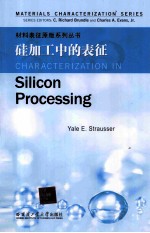
- 作 者:(美)布伦德尔,(美)埃文斯,(美)斯特劳瑟主编
- 出 版 社:哈尔滨:哈尔滨工业大学出版社
- 出版年份:2014
- ISBN:9787560342801
- 标注页数:240 页
- PDF页数:257 页
请阅读订购服务说明与试读!
订购服务说明
1、本站所有的书默认都是PDF格式,该格式图书只能阅读和打印,不能再次编辑。
2、除分上下册或者多册的情况下,一般PDF页数一定要大于标注页数才建议下单购买。【本资源257 ≥240页】
图书下载及付费说明
1、所有的电子图书为PDF格式,支持电脑、手机、平板等各类电子设备阅读;可以任意拷贝文件到不同的阅读设备里进行阅读。
2、电子图书在提交订单后一般半小时内处理完成,最晚48小时内处理完成。(非工作日购买会延迟)
3、所有的电子图书都是原书直接扫描方式制作而成。
APPLICATION OF MATERIALS CHARACTERIZATION TECHNIQUES TO SILICON EPITAXIAL GROWTH 1
1.1 Introduction 1
1.2 Silicon Epitaxial Growth 2
Basic Chemical Reactions 2
Precleaning Considerations 3
Reactor Types 3
1.3 Film and Process Characterization 4
Crystal Quality 4
Preclean Quality 6
Thickness 9
Dopant Concentration and Dopant Profiling 12
1.4 Selective Growth 14
Basic Process Considerations 14
Defect Density and Growth Morphology 15
Preclean Quality 18
Thickness 18
1.5 Si1-xGex Epitaxial Growth 18
Material Considerations 18
Reactor Types 19
1.6 Si1-xGex Material Characterization 20
Composition and Thickness 20
Growth Morphology 22
Lattice Strain and Critical Thickness 23
Relaxation Kinetics 24
Bandgap Measurements 24
Interfacial Abruptness and Outdiffusion 25
Impurity Profiles 25
1.7 Summary 26
POLYSILICON CONDUCTORS 32
2.1 Introduction 32
2.2 Deposition 33
Surface Preparation 34
Nucleation and Growth 35
Postgrowth Analysis 38
High-Quality Polysilicon 42
Integrated Circuit Fabrication Issues 43
2.3 Doping 45
Dopant Distribution 45
Deglaze 46
Ion Implantation Doping 46
2.4 Patterning 47
Lithography 47
Etching 47
2.5 Subsequent Processing 48
Polycides 48
Dielectric Encapsulation 49
SILICIDES 53
3.1 Introduction 53
3.2 Formation of Silicides 57
Sheet Resistance Measurements 57
Rutherford Backscattering Measurements 60
X-Ray Diffraction Measurements 72
Ellipsometric Measurements 74
3.3 The Silicide-Silicon Interface 76
3.4 Oxidation of Silicides 82
3.5 Dopant Redistribution During Silicide Formation 84
3.6 Stress in Silicides 87
3.7 Stability of Silicides 90
3.8 Summary 92
ALUMINUM-AND COPPER-BASED CONDUCTORS 96
4.1 Introduction 96
History 96
4.2 Film Deposition 98
Techniques 98
Problems with Deposition 101
4.3 Film Growth 104
Substrate Surface Properties 104
Surface Preparation 107
Film Formation 108
Microstructure 110
Patterning and Etching 110
4.4 Encapsulation 113
4.5 Reliability Concerns 114
TUNGSTEN-BASED CONDUCTORS 121
5.1 Applications for ULSI Processing 121
5.2 Deposition Principles 122
5.3 Blanket Tungsten Deposition 123
Film Thickness 123
Film Conformality 124
Film Resistivity 124
Film Stress 125
Surface Roughness 126
Film Microstructure 127
5.4 Selective Tungsten Deposition 127
Selectivity Breakdown 129
Substrate Interaction 131
BARRIER FILMS 138
6.1 Introduction 138
6.2 Characteristics of Barrier Films 139
6.3 Types of Barrier Films 140
6.4 Processing Barrier Films 140
Inert Sputtering 141
Reactive Sputtering 141
Chemical Vapor Deposition 142
Nitridation and Rapid Thermal Annealing 143
6.5 Examples of Barrier Films 143
Titanium Thin Films 144
Tungsten-TitaniumThin Films 149
Titanium Nitride 151
6.6 Summary 163
APPENDIX: TECHNIQUE SUMMARIES 169
1 Auger Electron Spectroscopy(AES) 169
2 Ballistic Electron Emission Microscopy(BEEM) 170
3 Capacitance-Voltage(C-V)Measurements 177
4 Deep Level Transient Spectroscopy(DLTS) 179
5 Dynamic Secondary Ion Mass Spectrometry(Dynamic SIMS) 181
6 Electron Beam Induced Current(EBIC) Microscopy 182
7 Energy-Dispersive X-Ray Spectroscopy(EDS) 188
8 Focused Ion Beams(FIBs) 189
9 Fourier Transform Infrared Spectroscopy(FTIR) 193
10 Hall Effect Resistivity Measurements 194
11 Inductively Coupled Plasma Mass Spectrometry(ICPMS) 196
12 Light Microscopy 197
13 Low-Energy Electron Diffraction(LEED) 198
14 Neutron Activation Analysis(NAA) 199
15 Optical Scatterometry 200
16 Photoluminescence(PL) 201
17 Raman Spectroscopy 202
18 Reflection High-Energy Electron Diffraction(RHEED) 203
19 Rutherford Backscattering Spectrometry(RBS) 204
20 Scanning Electron Microscopy(SEM) 205
21 Scanning Transmission Electron Microscopy(STEM) 206
22 Scanning Tunneling Microscopy and Scanning Force Microscopy(STM and SFM) 207
23 Sheet Resistance and the Four Point Probe 208
24 Spreading Resistance Analysis(SRA) 217
25 Static Secondary Ion Mass Spectrometry(Static SIMS) 225
26 Surface Roughness:Measurement Formation by Sputtering,Impact on Depth Profiling 226
27 Total Reflection X-Ray Fluorescence Analysis(TXRF) 227
28 Transmission Electron Microscopy(TEM) 228
29 Variable-Angle Spectroscopic Ellipsometry(VASE) 229
30 X-Ray Diffraction(XRD) 230
31 X-Ray Fluorescence(XRF) 231
32 X-Ray Photoelectron Spectroscopy(XPS) 232
Index 233
